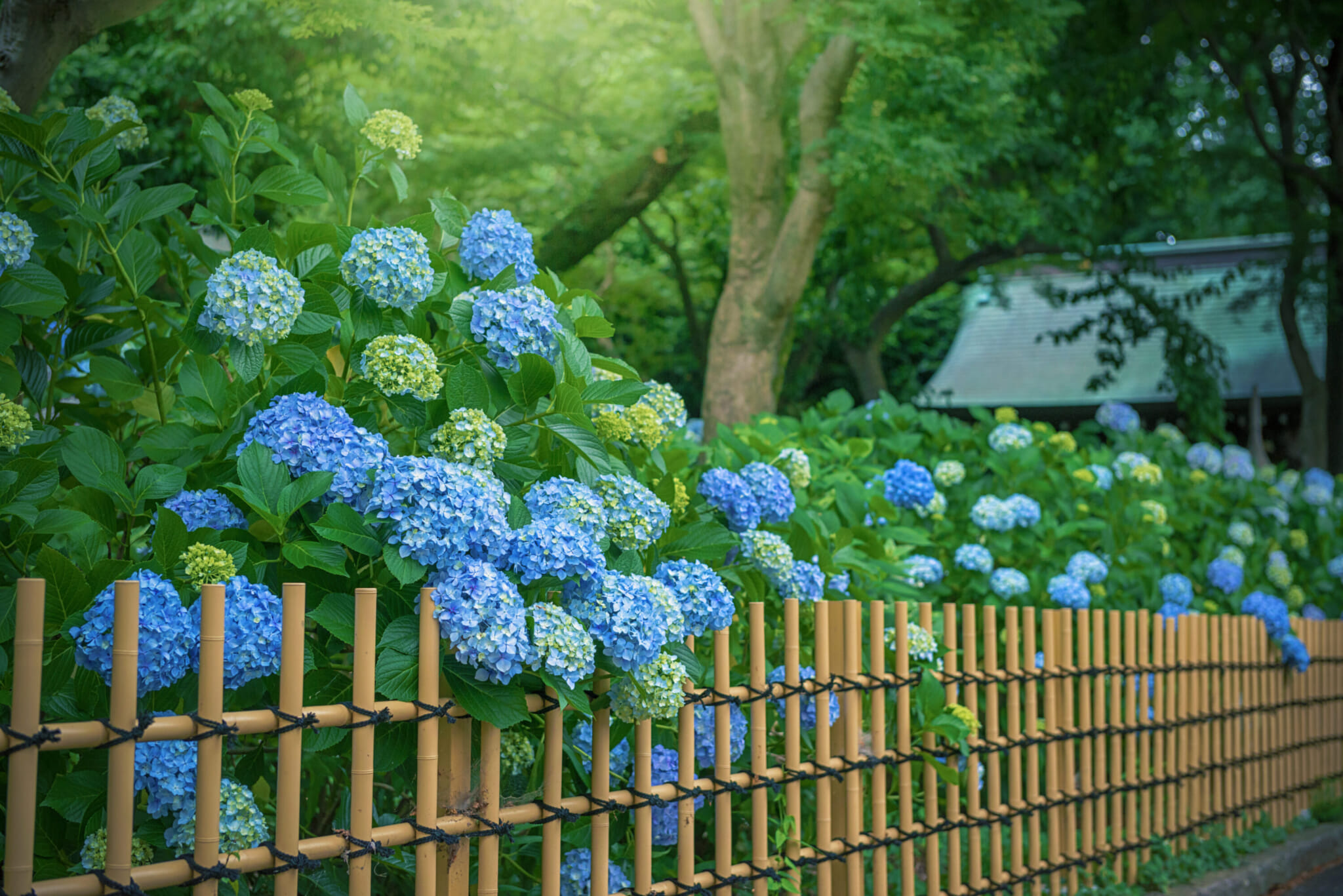Tokyo
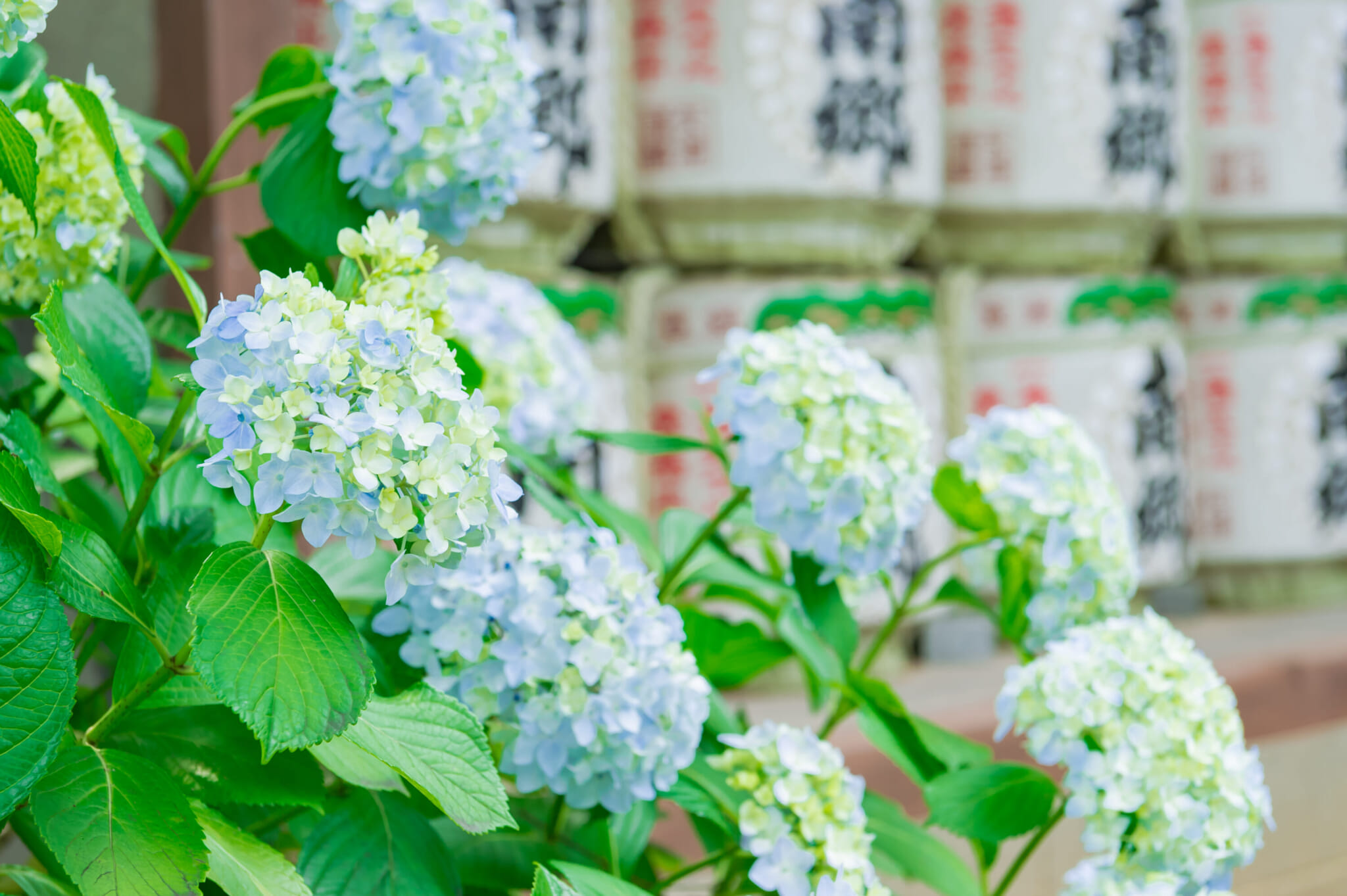
Photo by zu_kuni via Shutterstock
1.
Hakusan Shrine
Located in Bunkyo, Tokyo, Hakusan Shrine holds an annual hydrangea festival, called the Ajisai Matsuri. It’s only a few minutes away from the Tokyo Metro Hakusan Station. Visitors can also enjoy various Japanese festival treats sold on roadside food carts.
2.
Takahata Fudoson Kongoji Temple
Takahata Fudoson Kongoji Temple is in Hino, Tokyo and is one of the three famous Fudo temples in the Kanto region. There are around 7,500 hydrangeas of 200 types. It is located beside a mountain where you can go for a little hike.
Kanagawa
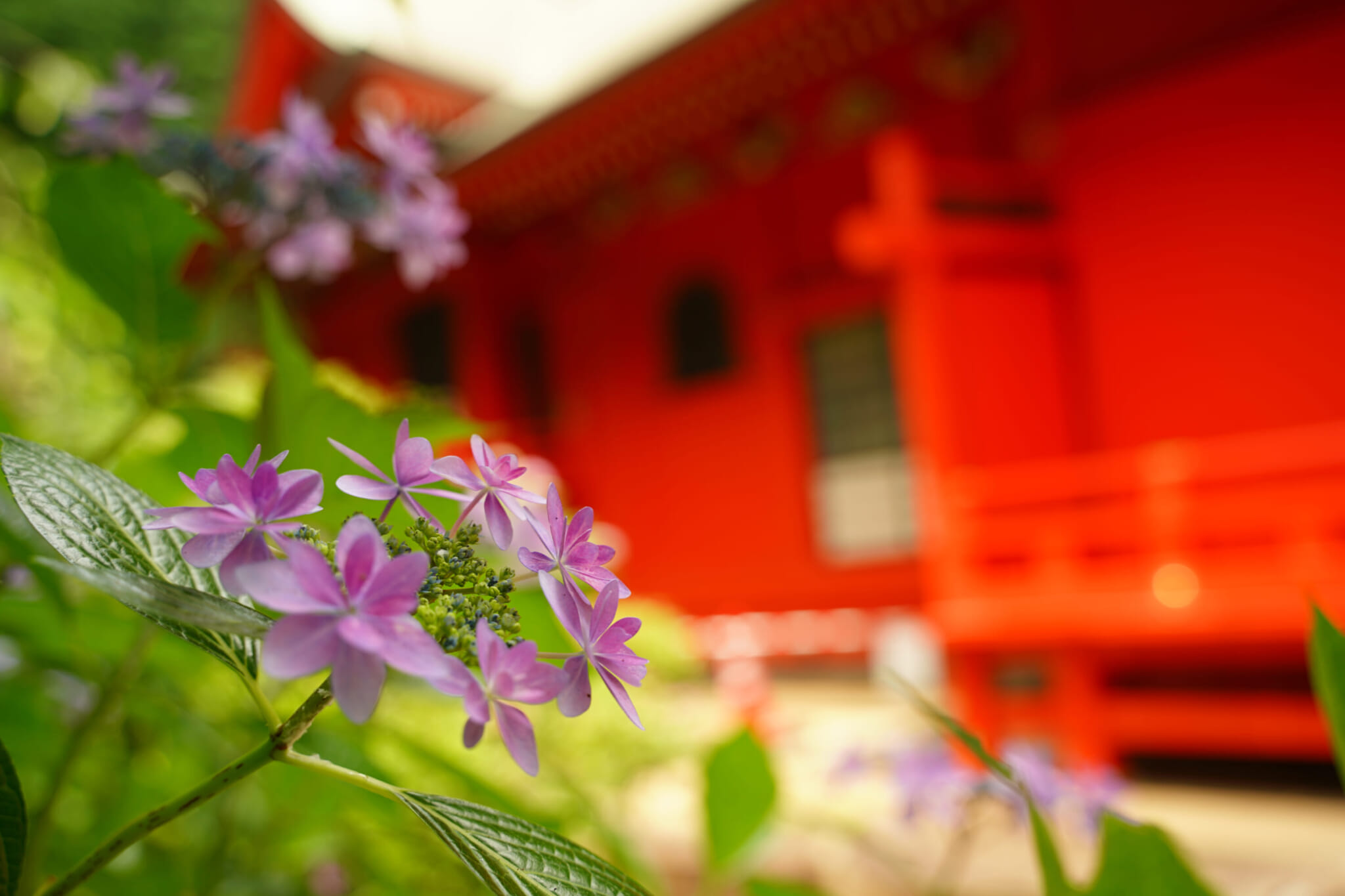
Photo by dokosola via Shutterstock
3.
Enoshima Shrine
Enoshima Shrine, where the gods of fishing and sea transportation are worshipped, is also famously known to have Japanese good luck tokens called ema. Two notable hydrangea spots at Enoshima Shrine are the Zuishinmon tower gate and the red torii gate. The landscape is stunning.
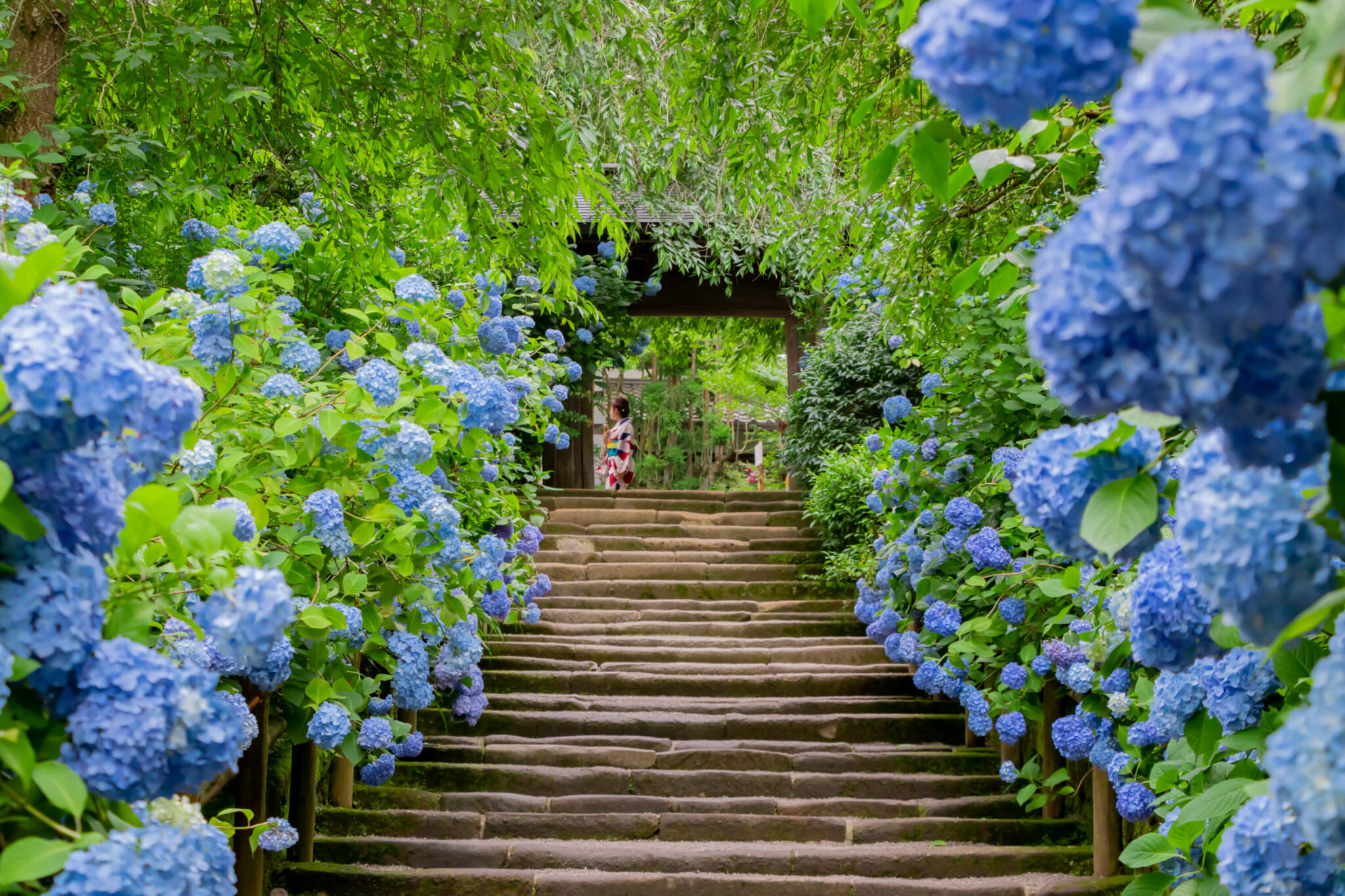
Photo by Princess_Anmitsu via Shutterstock
4.
Meigetsuin Temple
Located in Kamakura, and nicknamed Ajisai Dera, literally hydrangea temple in Japanese, Meigetsuin Temple has a garden filled with over 2,500 hydrangea bushes, boasting a wide range of blue and purple hues. Visitors can take a leisurely stroll through the garden and enjoy the serene atmosphere while admiring the vibrant blooms.
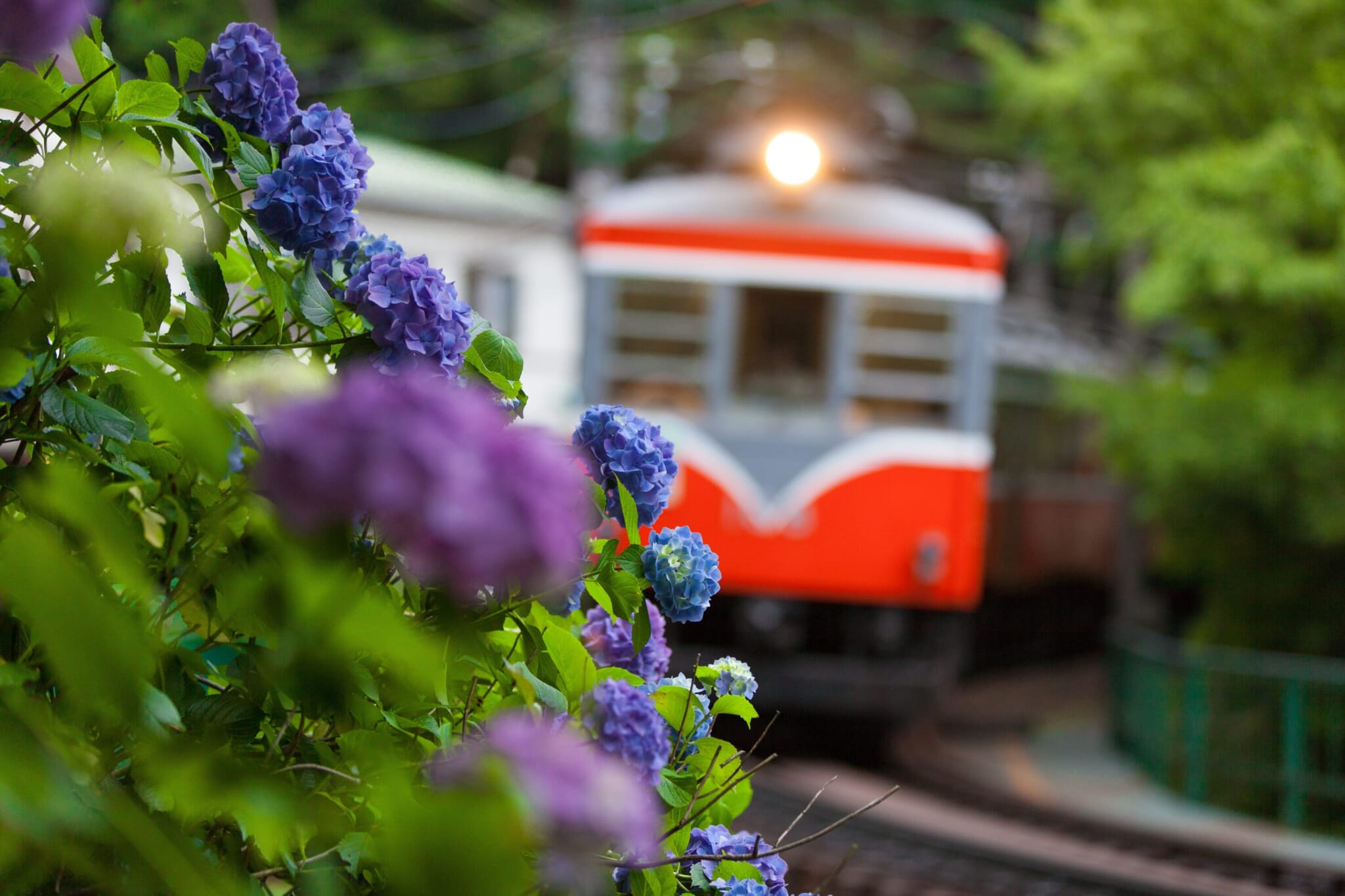
Photo by t-nakada via Shutterstock
5.
Hakone Tozan Railway
Every rainy season, thousands of hydrangeas blossom along the mountainside where the Hakone train tracks run. The Hakone Tozan Railway, which goes from Yumoto to Gora, celebrated its 100th anniversary in 2019. Usually, during the hydrangea season, the trains run in the evening, when you can ride the “Ajisai Train” and enjoy the gorgeously lit-up hydrangeas. Stations along the railway all show hydrangeas in different photogenic spots.
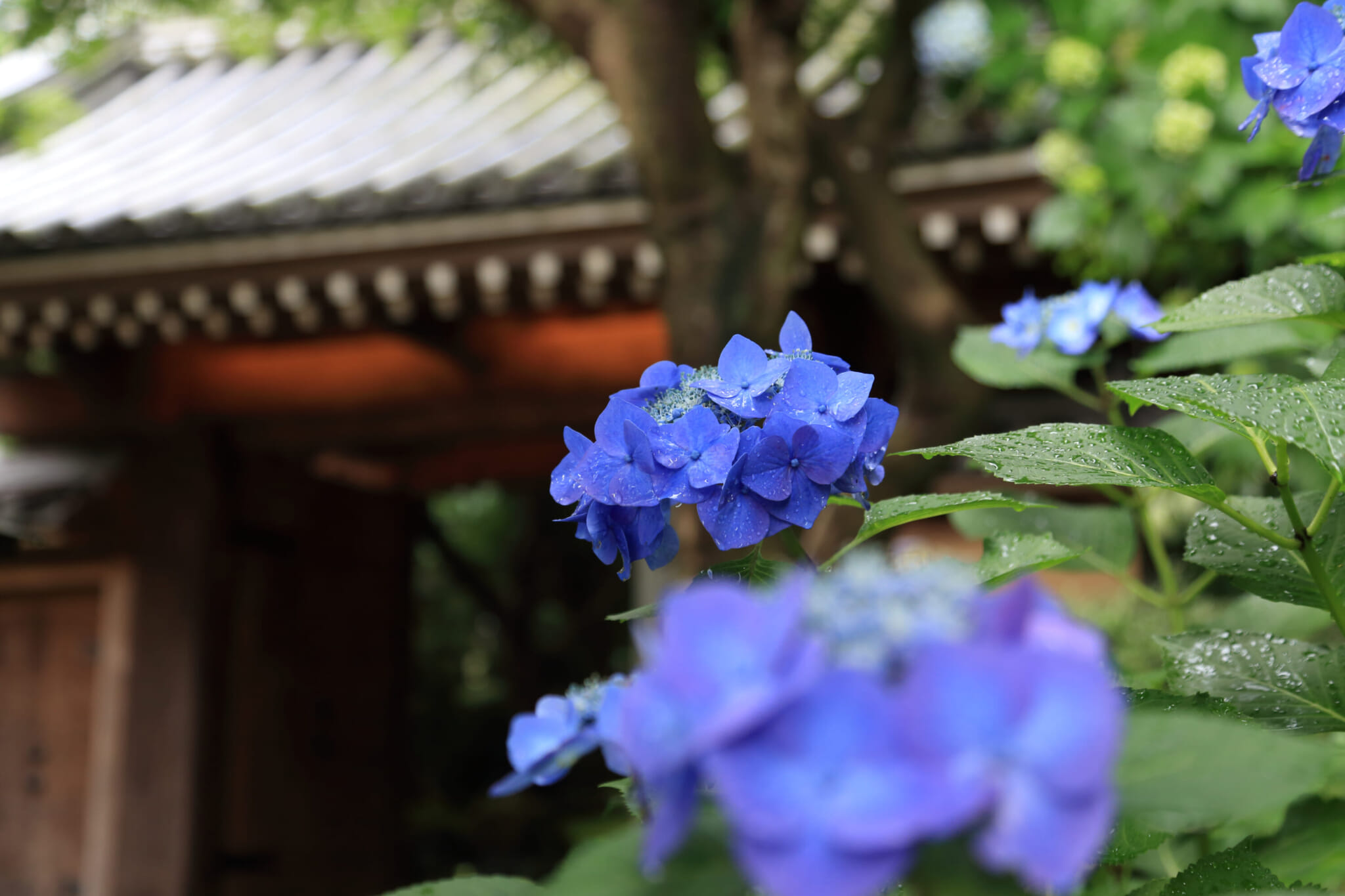
Photo by funboxphoto via Shutterstock
6.
Hasedera Temple
Also in Kamakura, Hasedera Temple has more than 40 varieties of hydrangeas during the rainy season. It is famed for its 11-faced wooden Kannon statue and the beautiful ocean view. Izu Oshima island can be seen on sunny days.
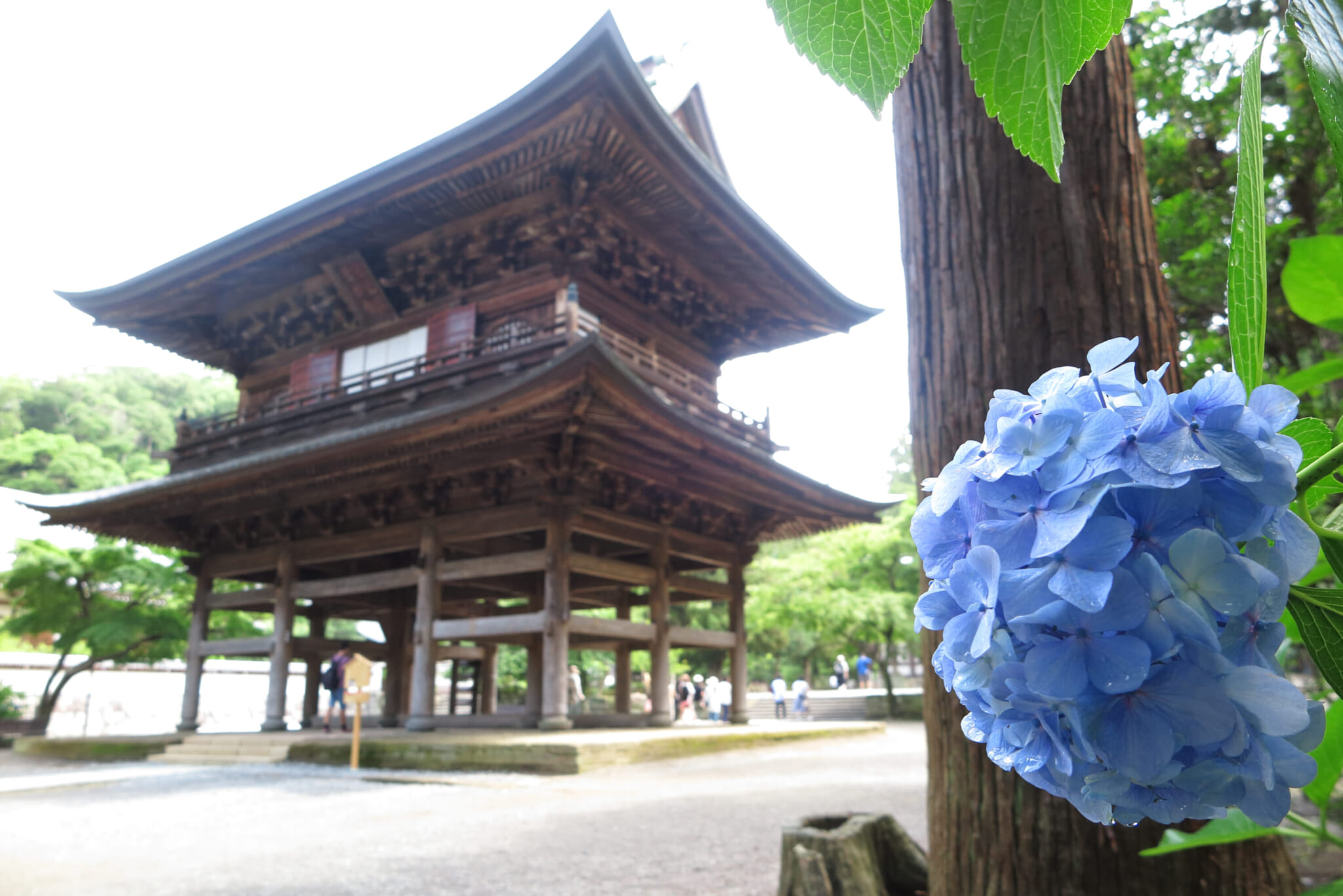
Photo by funboxphoto via Shutterstock
7.
Engakuji Temple
Known as one of the top five Zen temples in Kamakura, Engakuji has grown in size since its construction in 1282 by Hojo Tokimune. It’s also widely known for its appearance as a setting in the literary works of Natsume Soseki’s The Gate and Thousand Cranes by Japan’s first Nobel literature laureate, Yasunari Kawabata. The most popular season to visit Engakuji is in autumn, but you can’t skimp out on the hydrangea season. The most impressive place to see the vibrant flowers is near the massive Sanmon gate. Check out the tea garden where you can have a cup of matcha green tea and a plate of traditional Japanese sweets in the shape of a hydrangea.
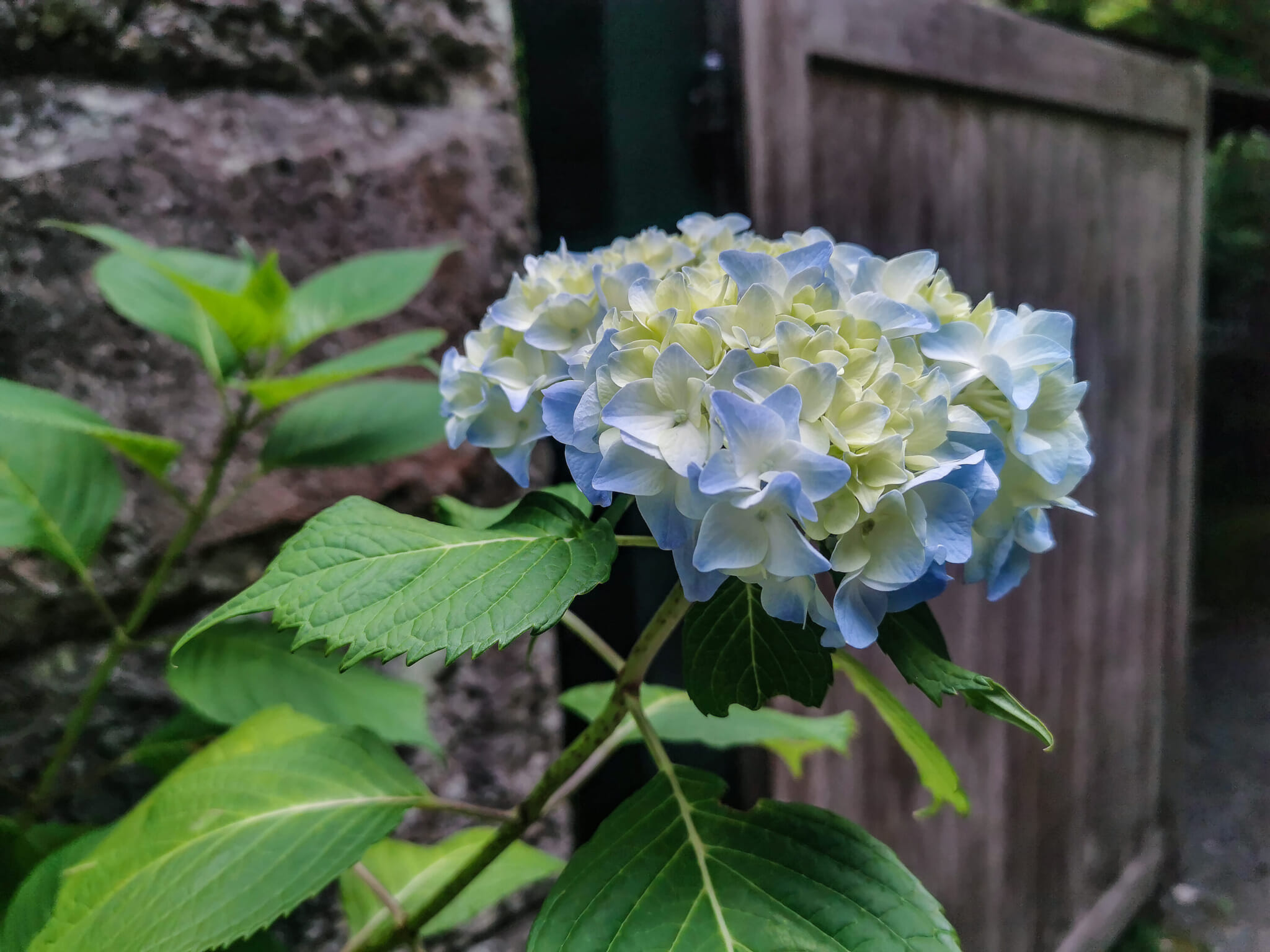
Photo by Starshooting via Shutterstock
8.
Jojuin Temple
Jojuin Temple, originally built in 1219 during the Kamakura Period, looks out onto Yuigahama Beach. On the pathway of the 108 steps to the top of the mountain, you’ll see colorful varieties of hydrangeas. With the ocean in the background, it makes for a memorable photo.
Chiba
9.
Hattori Farm Hydrangea House
As the name suggests, the Hattori Farm Hydrangea House is known for its hydrangeas that only bloom for a limited time in June. There are more than 250 varieties here. Growing a great number of hydrangeas is no easy task and a continuous work in progress. Visitors get to see a new side to the Hydrangea House every year.
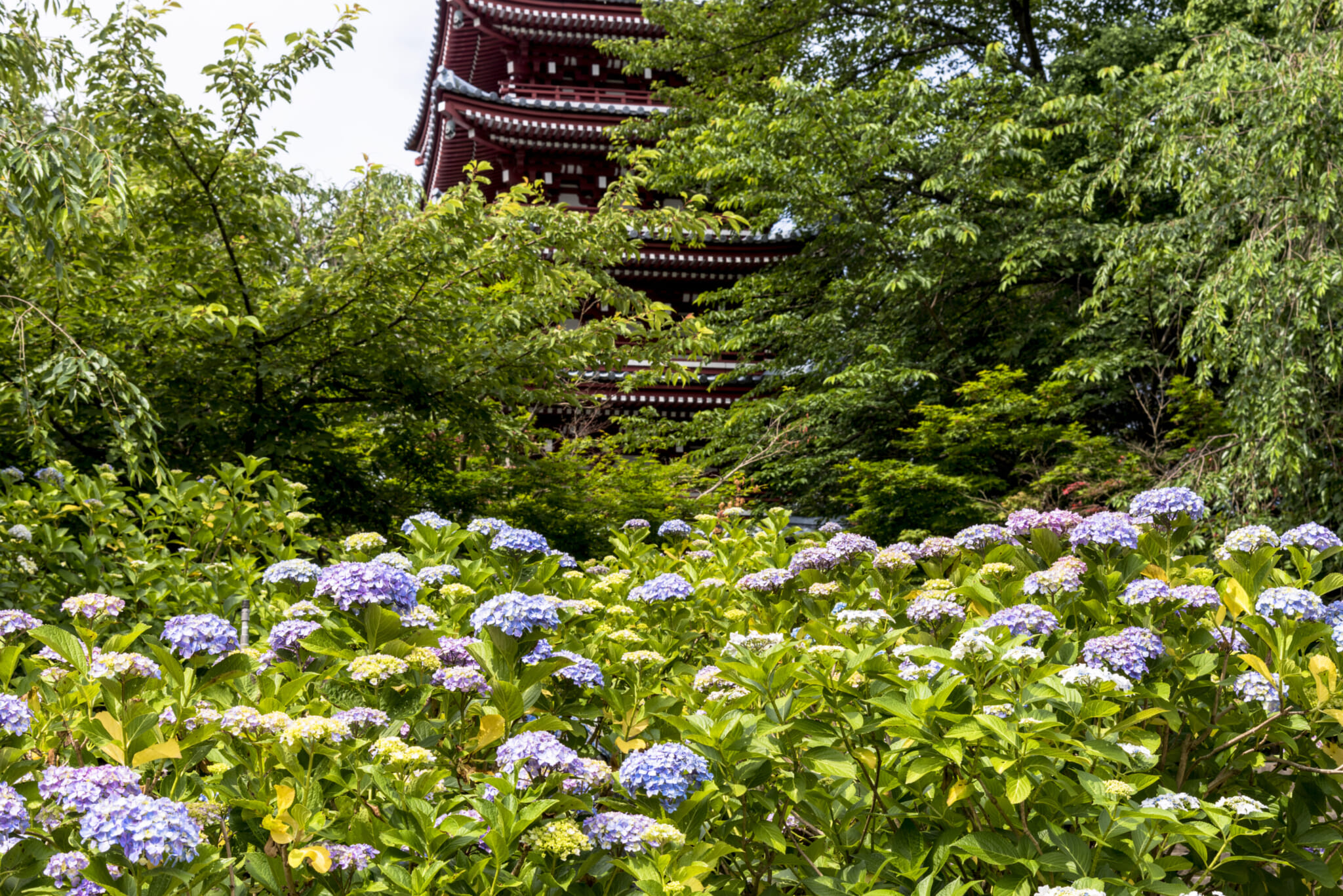
Photo by San Hoyano via Shutterstock
10.
Hondoji Temple
Located in the suburbs of Matsudo city, Chiba, Hondoji Temple grows more than 50,000 hydrangeas. Built in 1277, it is also a great place to visit in the spring time for cherry blossoms, during the rainy season for irises and in autumn for maple trees. Check out the five-story pagoda for the best hydrangea photo spot. It is surrounded by clusters of hydrangeas and is a sight to see from a low angle as the pagoda looks like it’s reaching for the sky. Take a walk along Myorodo, as the path is lined with hydrangeas on both sides.
Akita
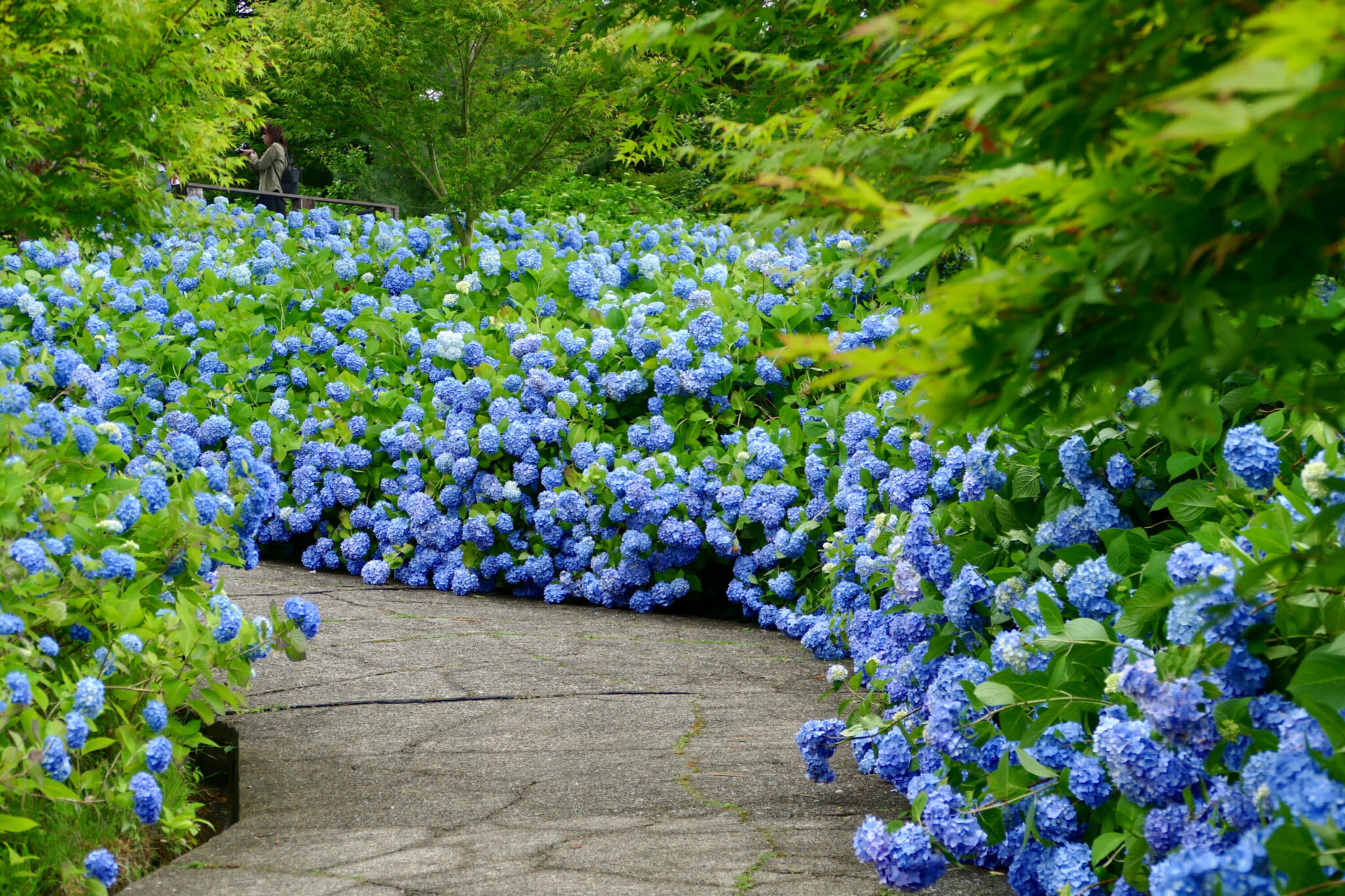
Photo by Shirakami via Shutterstock
11.
Unshouji Temple
Unshouji Temple is known as “a place you must visit before you die.” Shuun Konaka, the deputy chief priest there, was entranced by a hydrangea growing on the temple grounds. His love for the flower led him to propagate 1,500 hydrangeas in and around the temple, so when they’re in bloom, the whole garden is overflowing like an ocean of blue. With the backdrop of the Kitaura port town and Olga Bay, it’s a sight not to be missed.
Shizuoka
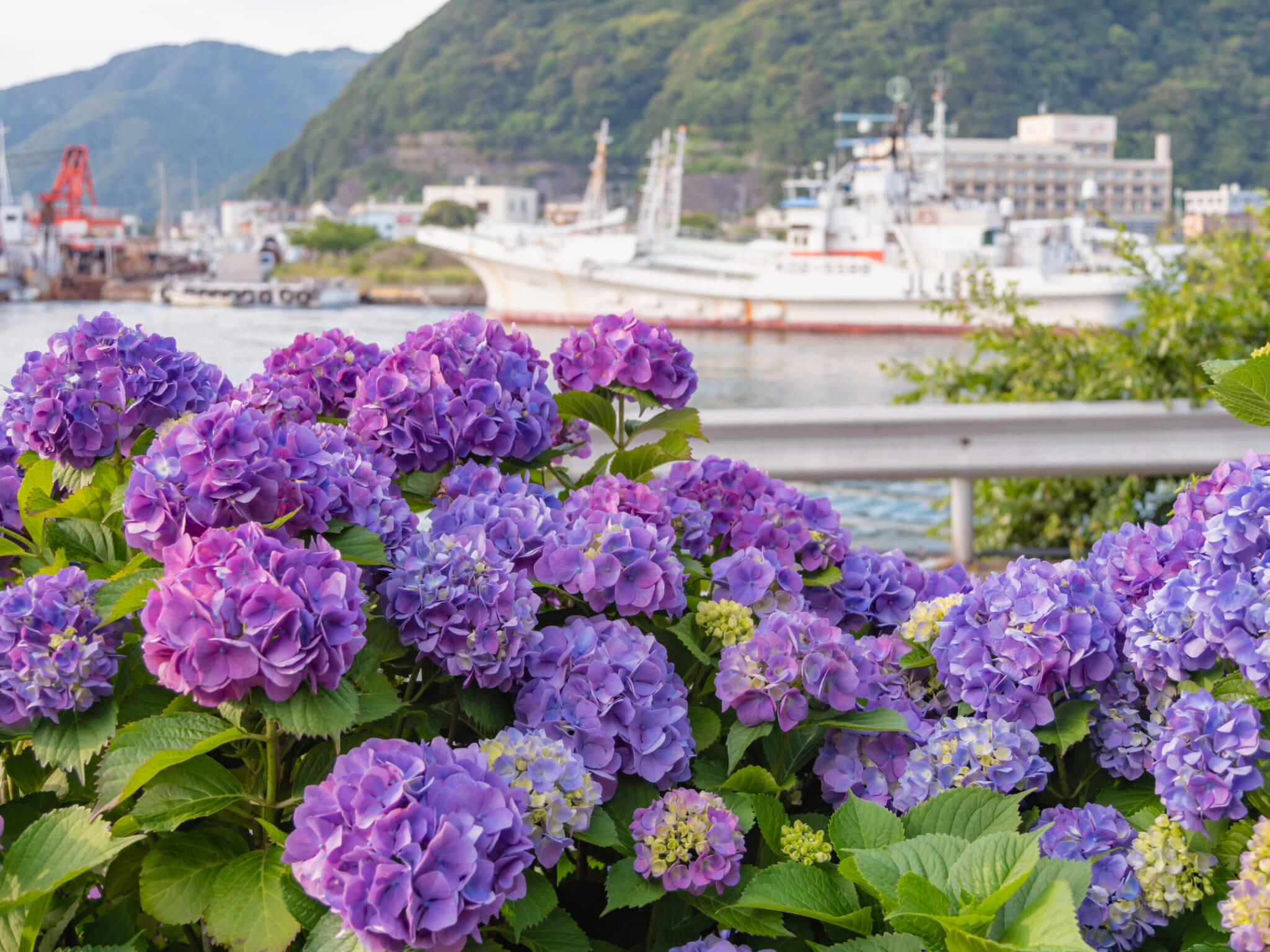
Photo by okimo via Shutterstock
12.
Shimoda Park
Encircling the ruins of Ushima Castle, Shimoda Park holds an annual hydrangea festival. It also features a monument, built in 1957, dedicated to US-Japan diplomatic relations. Around 3 million hydrangeas are grown on the mountain side. The park overlooks Shimoda Bay and is full of its iconic pink, purple and blue hydrangeas.
13.
Hamamatsu Flower Park
Established in 1970, the 300,000-square meter Hamamatsu Flower Park hosts a wide range of domestic and exotic flowers and plants, including hydrangeas. A flower lover’s paradise, it is perfect to visit anytime throughout the year.
Nara
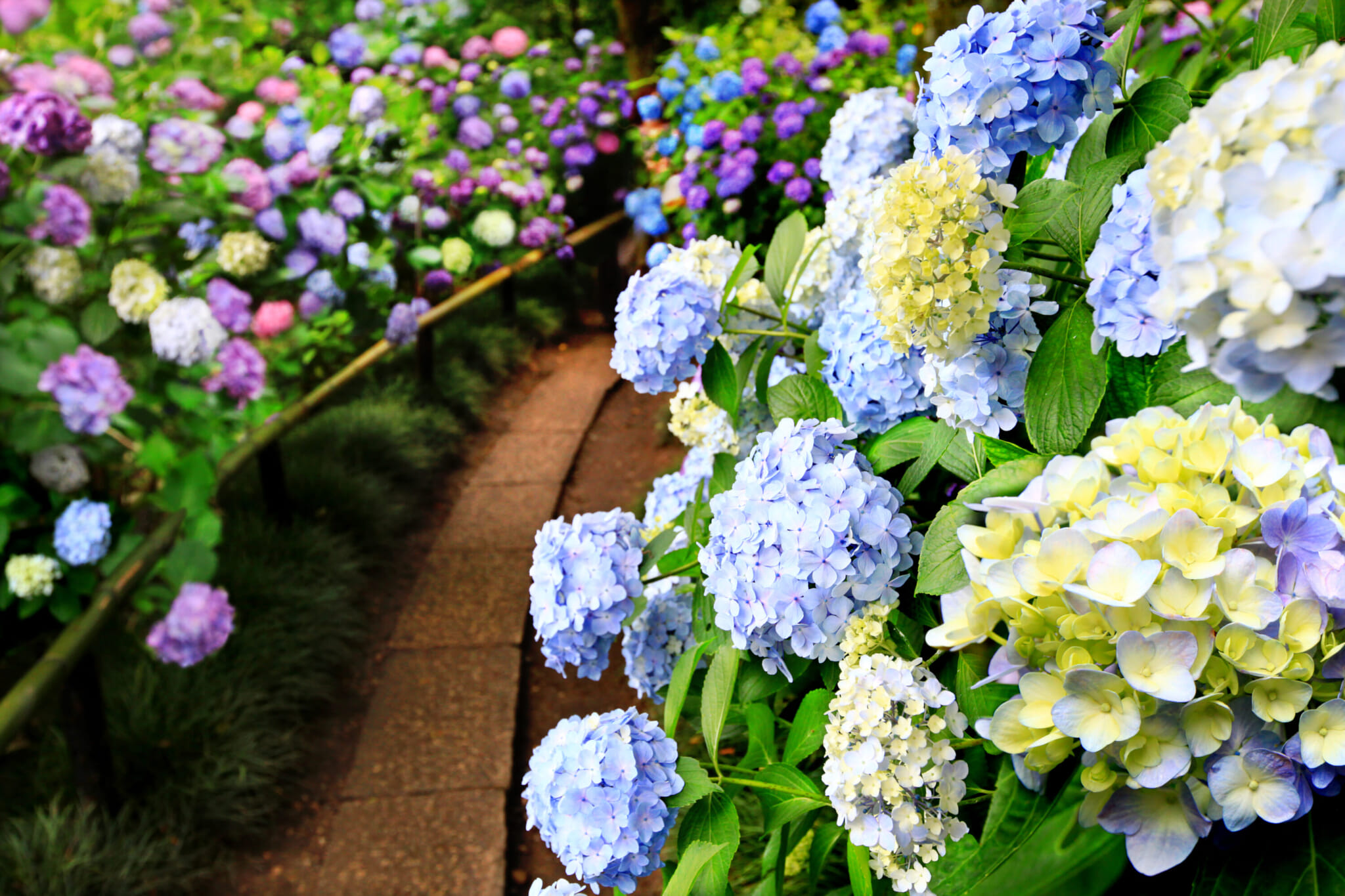
Photo by jirobkk via Shutterstock
14.
Yatadera
A favorite hydrangea spot to visit for the locals in Nara, there are around 10,000 trees of pink, blue and purple hydrangeas at Yatadera with Jizo statues scattered in between the bushes. The hydrangea gardens are only open to the public during rainy season. Special hydrangea-inspired bento lunches are available for purchase during the season as well.
Tochigi
15.
Ohirasan Shrine
Located on the mountainside, Ohirasan Shrine is a great hydrangea viewing spot. The hydrangeas have been cultivated for a long time as they were first grown by the Lion Club in 1974. Visitors can enjoy more than 2,500 hydrangeas lining up on both sides of the 1,000 steps to the top of the mountain. All of the stones used to build the steps are from the mountain itself. At the top, visitors can rest and relax at a traditional Japanese tea house.
Kyoto
16.
Fujinomori Shrine
Located in southern Kyoto, Fujinomori Shrine is said to have been founded by Empress Jingu before Kyoto became Japan’s capital. The origin of Children’s Day was born here. In June, it opens its hydrangea garden to the public. Split into two, it surrounds the north and south of the shrine. There are 3,500 pink, white, blue and purple hydrangeas and the shrine also holds an annual hydrangea festival which includes special prayers and performances.
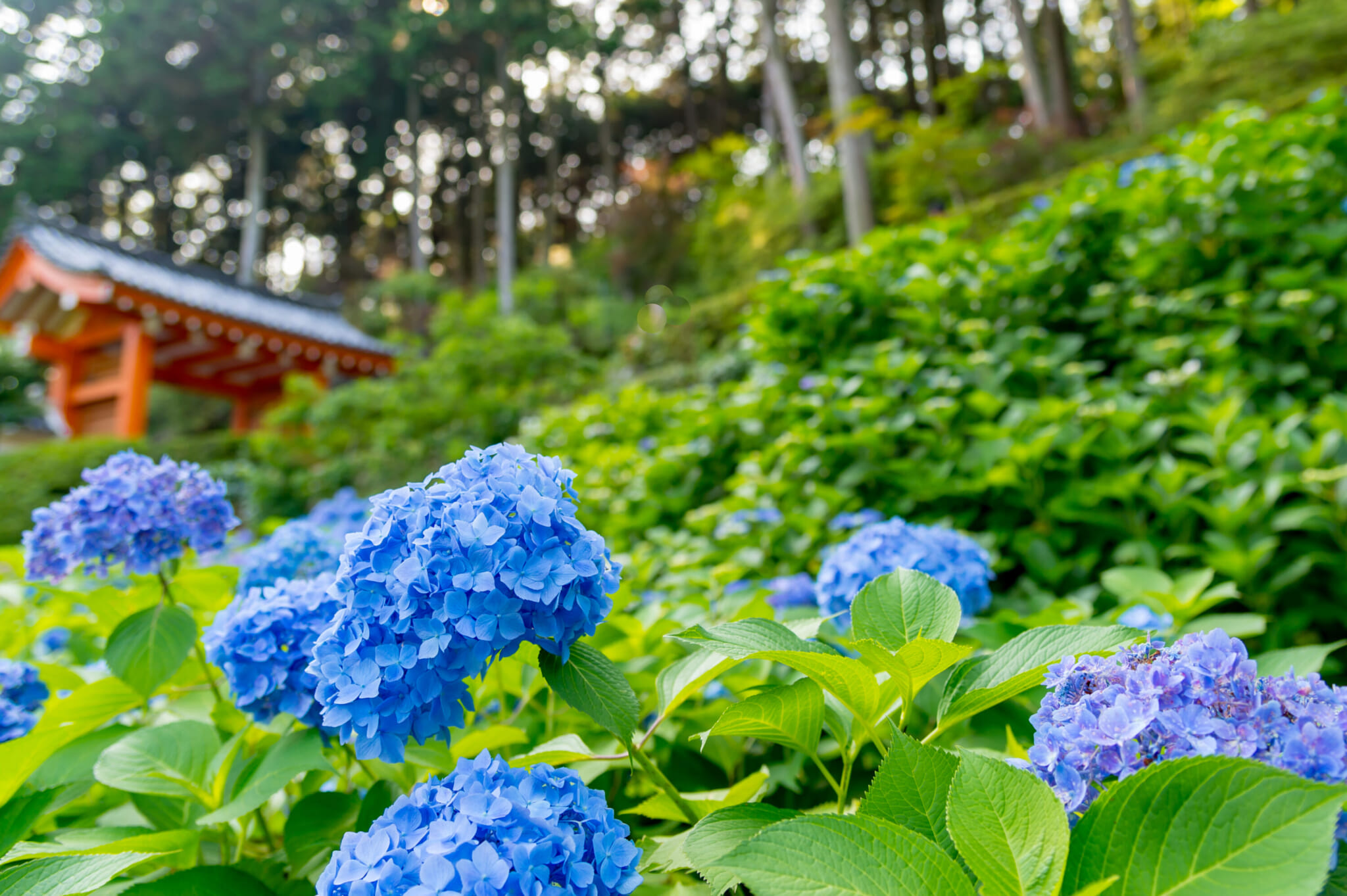
Photo by Taromon via Shutterstock
17.
Mimurotoji Temple
Built around 1,200 years ago, Mimurotoji Temple is currently known as Kansai’s hydrangea paradise. Legend foretold that in the 8th century, Emperor Konin saw an unusual beam of light and found a huge Kannon Bosatsu statue in the Uji River after traveling for several days. Konin built the temple to enshrine the miniature-sized Kannon statues. Mimurotoji Temple boasts around 20,000 hydrangeas in 50 varieties. Visitors can also enjoy hydrangea-themed sweets and treats in the tea house located in the middle of the garden.
18.
Maizuru Nature and Cultural Park
Another popular spot in the Kansai region, visitors can enjoy 100,000 hydrangeas at the Maizuru Nature and Cultural Park. It’s nicknamed the Sea of Hydrangeas, as blue, white and purple hydrangeas blossom throughout the grounds. Visitors can also enjoy watching hydrangeas being replanted or plant them themselves. There are then mini-performances and other fun activities.
Hyogo
19.
Kobe City Botanical Forest Garden and Municipal Arboretum
Kobe City Botanical Forest Garden and Municipal Arboretum is only a 25-minute drive from the city center. Visitors can choose a hiking course that fits them. They can also enjoy 1,200 domestic and international exotic trees and plants. As the hydrangea is Kobe’s official flower, there is an annual “Hydrangea Walk in the Forest” event.
Nagasaki
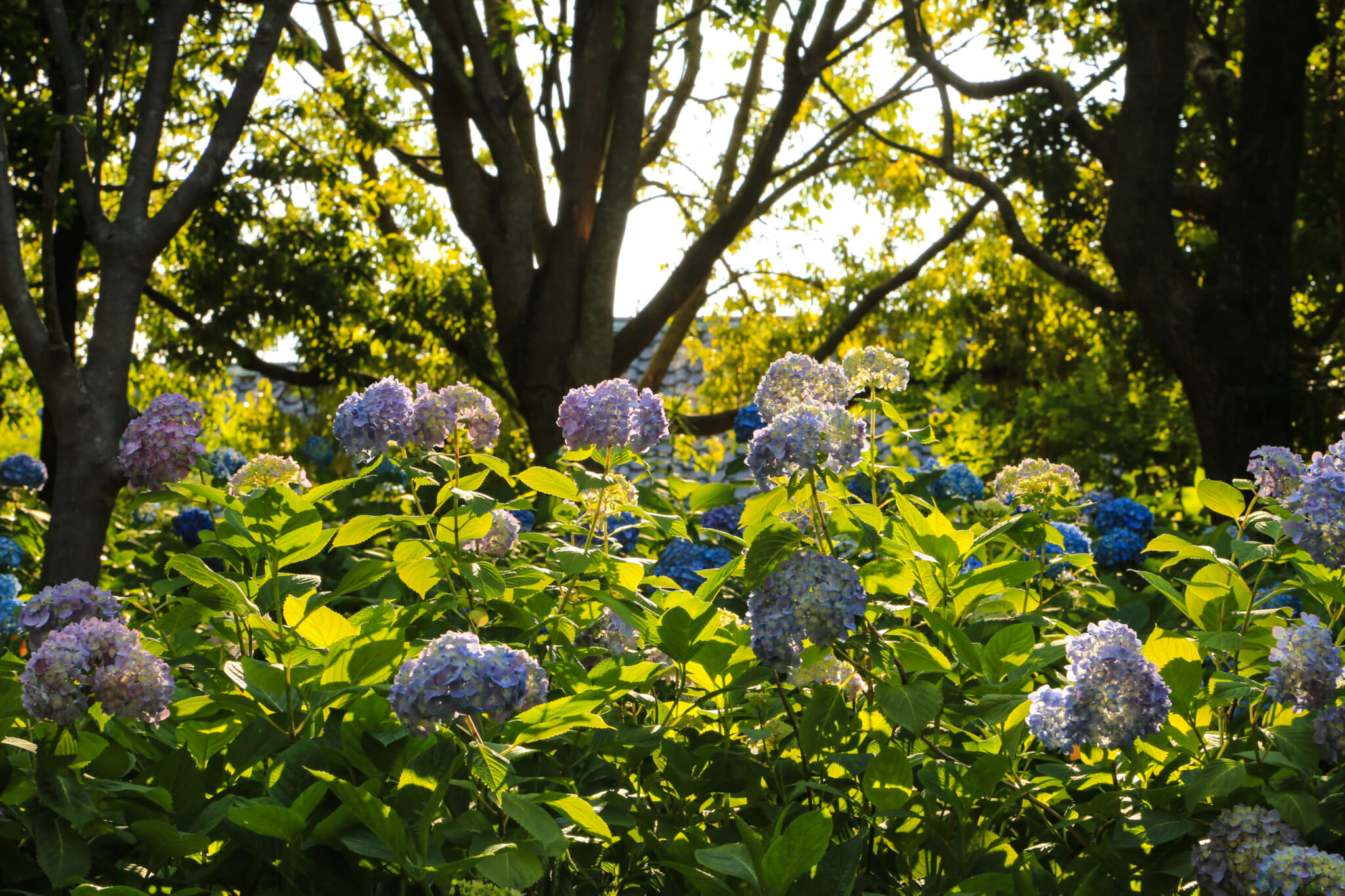
Photo by sieghartatelier via Shutterstock
20.
Huis Ten Bosch
Huis Ten Bosch, Nagasaki’s Dutch-inspired theme park, holds an annual hydrangea festival. Imagine European architecture and Disneyland escapism, complete with an actual canal running through the park leading to the ocean. Added to that are the seasonal flowers, including, of course, hydrangeas. Huis Ten Bosch features around 1,250 types of hydrangeas in various spots of the theme park. Visitors can also enjoy the exclusive Huis Ten Bosch hydrangea, which is named after the park itself.
Yamagata
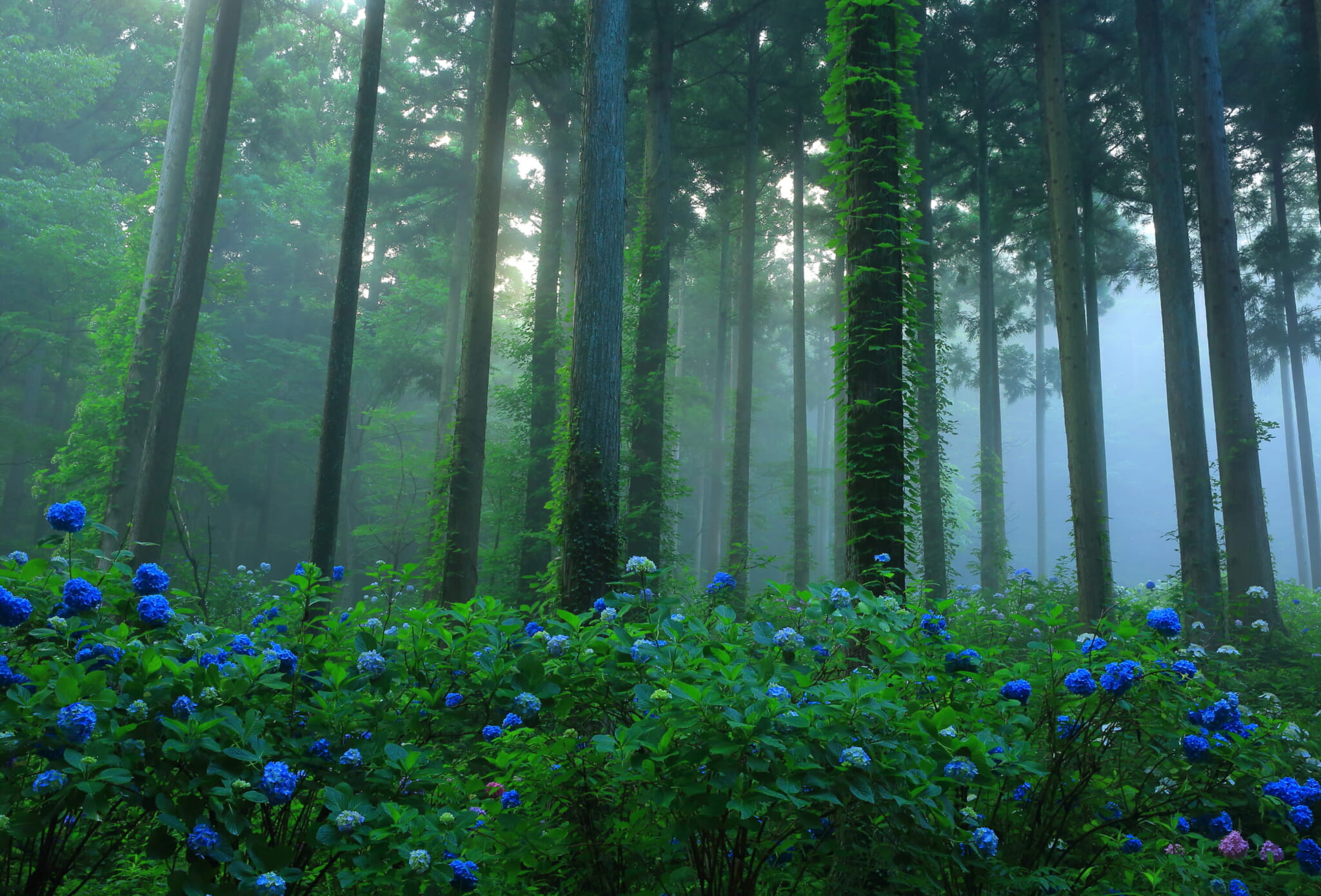
Photo by yspbqh14 via Shutterstock
21. Higashiyama Park Hydrangea Forest
Higashiyama Park Hydrangea Forest is a superb hydrangea spot in Shinjo city, Yamagata Prefecture. Shinjo city’s official flower is the hydrangea and there are around 45,000 hydrangeas of seven types planted in the park. The color of hydrangeas in the park ranges from blue to white and magenta. Considered a popular photogenic spot, it’s free to visit.
Yamanashi
22.
Utsubuna Park
Overlooking the Fujikawa River, Utsubuna Park is located on a small hill, near the town of Utsumi. A popular flower viewing spot in Yamanashi Prefecture, the park hosts around 30,000 hydrangeas, with 90 varieties. On the inclines of the hill, visitors can enjoy hydrangeas ranging in color from blue, purple, pink, white and infinite shades in between those colors. The hydrangeas here are planted and cared for by devoted volunteers. The Nanbu Ajisai Festival is held annually.
Fukushima
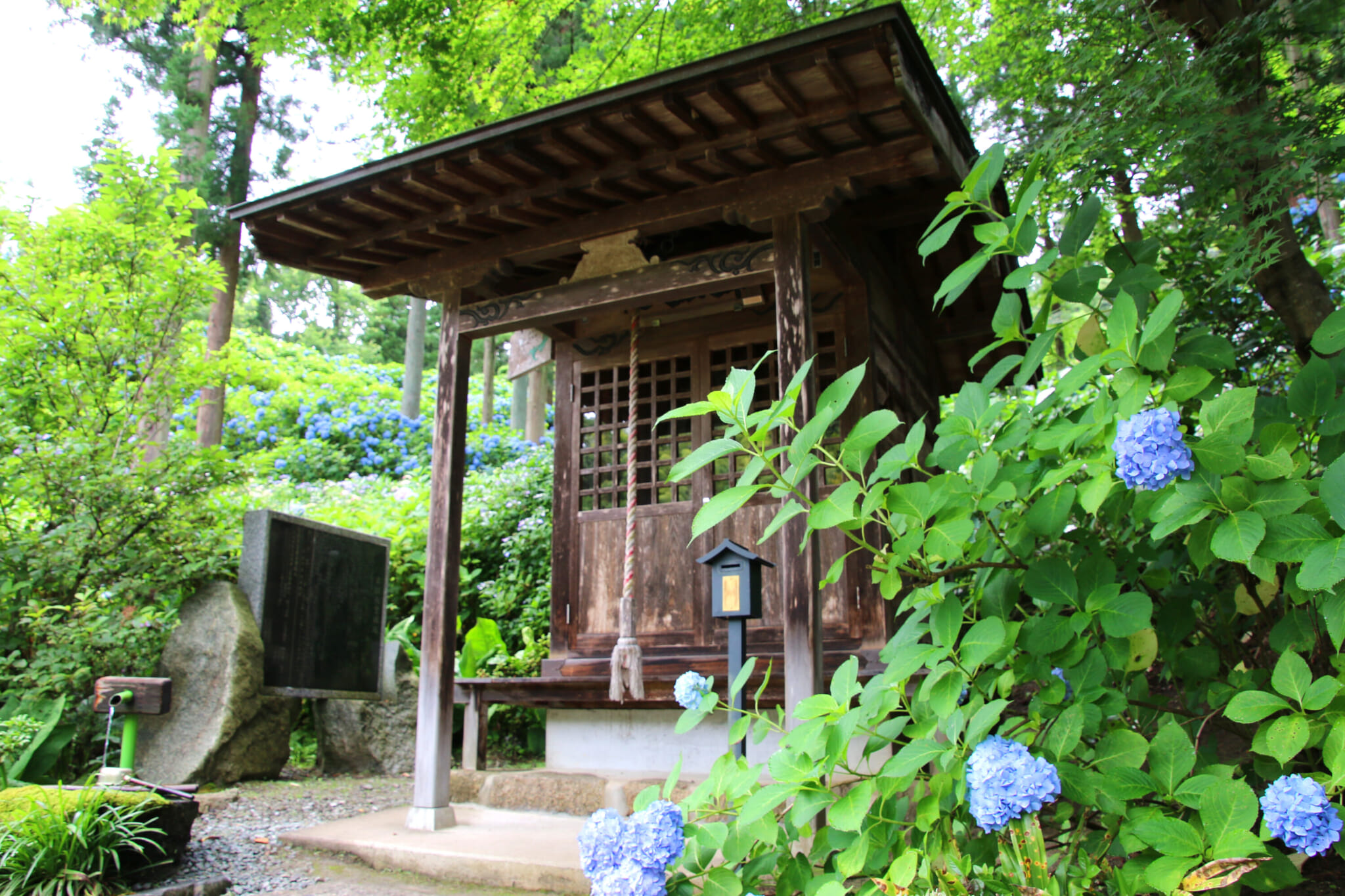
Photo by Musashi2001 via Shutterstock
23.
Korinji Temple
A famed hydrangea spot in Fukushima, there are around 5,000 hydrangeas of 20 types at Korinji Temple. The easiest way to get there is by car and, as the temple is located on a steep hill, expect a bit of a hike. Feel free to explore the small paths to view different colored and differently shaped flowers. Throughout the temple, there are also a lot of statues and traditional buildings.
Iwate
24.
Michinoku Hydrangea Garden
Officially certified by the Japan Hydrangea Association as Japan’s number one hydrangea garden, Michinoku Hydrangea Garden is a must-visit hydrangea spot in Iwate Prefecture. The garden is in the forest and gives off a magical feel when you walk among the multi-colored hydrangeas. It has around 40,000 hydrangeas ranging from 400 types. There are three trails that are all interconnected. It’s possible to travel by car and on foot. The smaller routes throughout the garden can only be traveled on foot.
Kagoshima
25.
Shinonome no Sato Hydrangea Garden
Kagoshima’s famed Shinonome no Sato Hydrangea Garden is a vast garden located in the valley of a hill. Established in 1995, the garden has around 100,000 hydrangeas with more than 200 varieties. The paths in the garden guide visitors through numerous rows of hydrangea bushes and lead up to a breathtaking waterfall. After a long walk, rest and relax with a bowl of noodles or cup of tea at the soba restaurant in the garden. Cakes and other sweets are available as well.
Aichi
26.
Honkoji Temple
Located in Kota town, south of Okazaki city, is Honkoji Temple, the family temple of the Fukozu Matsudaira clan. The temple is also nicknamed “Mikawa’s Temple of the Hydrangeas.” Built in 1520, it boasts around 10,000 hydrangea bushes that bloom in various shades and colors. The temple also celebrates the hydrangea festival every year. Additionally, there are small booths selling local products, including homemade goods and vegetables.
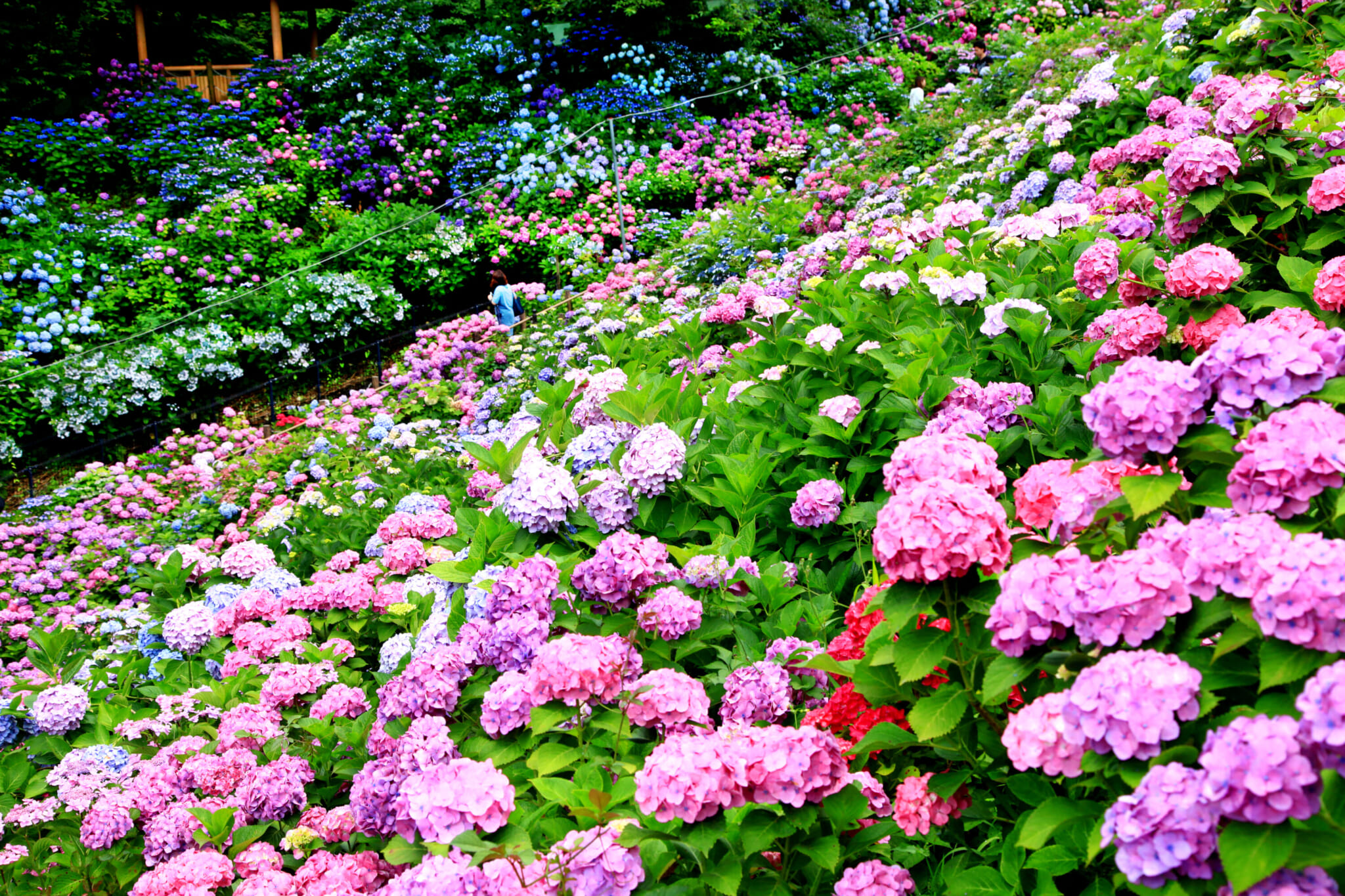
Photo by jirobkk via Shutterstock
27.
Katahara Onsen
Located on the coast of Mikawa Bay, Katahara Onsen is a scenic hot spring location. You’ll find Hodagaike Pond there, which is known as the “Home Place of Hydrangeas,” as there are around 50,000 of the colorful flowers along the pathway of the pond. It’s a remarkable sight at night as the flowers are lit up and, if you are lucky enough, fireflies also illuminate the pond.
Shiga
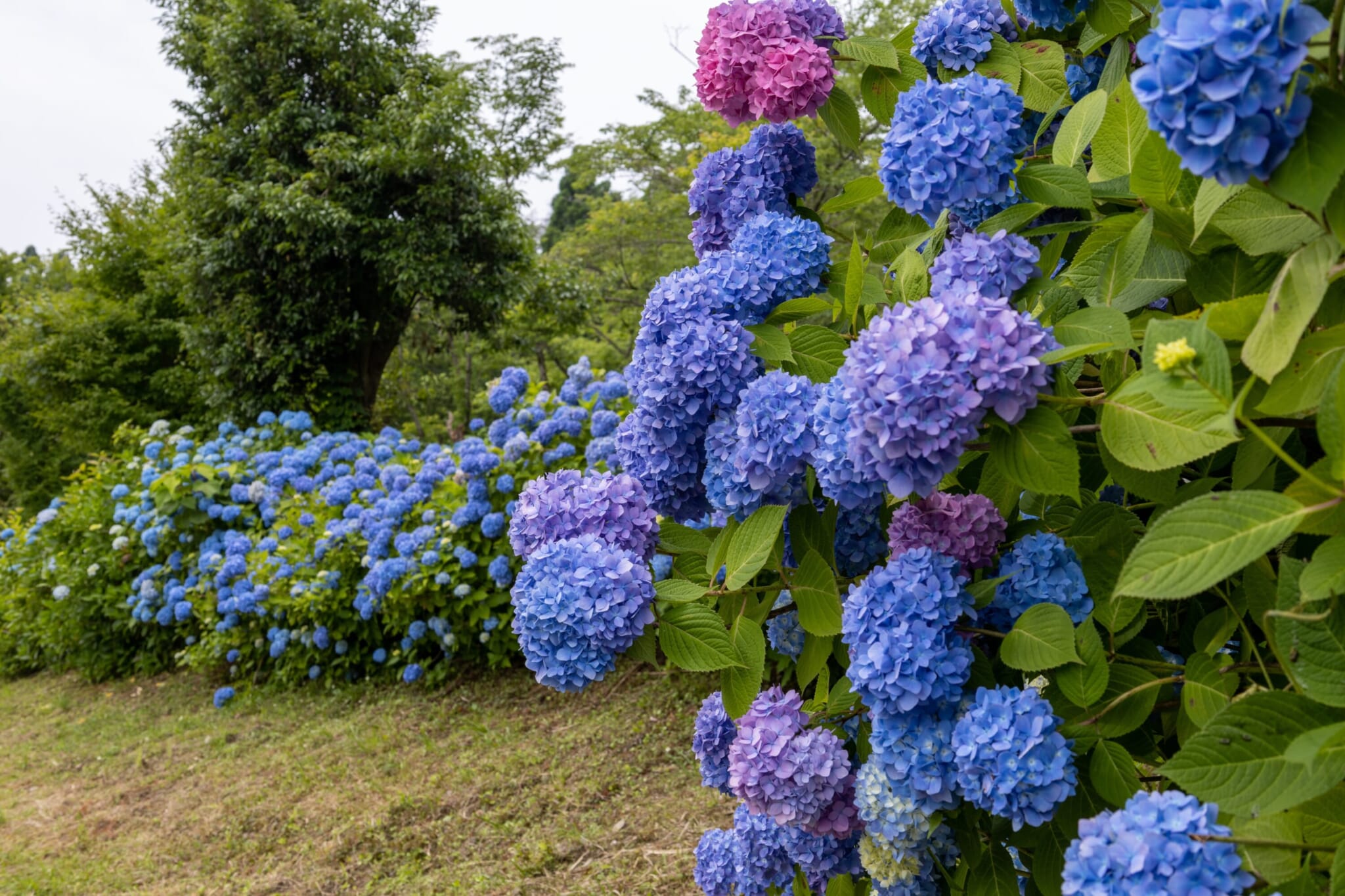
Photo by Yoshi.D via Shutterstock
28.
Lake Yogo
Situated on the north side of Lake Biwa, Lake Yogo is another water landscape perfect for hydrangea viewing. There are around 10,000, which makes for a mystical sight. Nicknamed “mirror lake,” it is also a popular spot for fishing.

